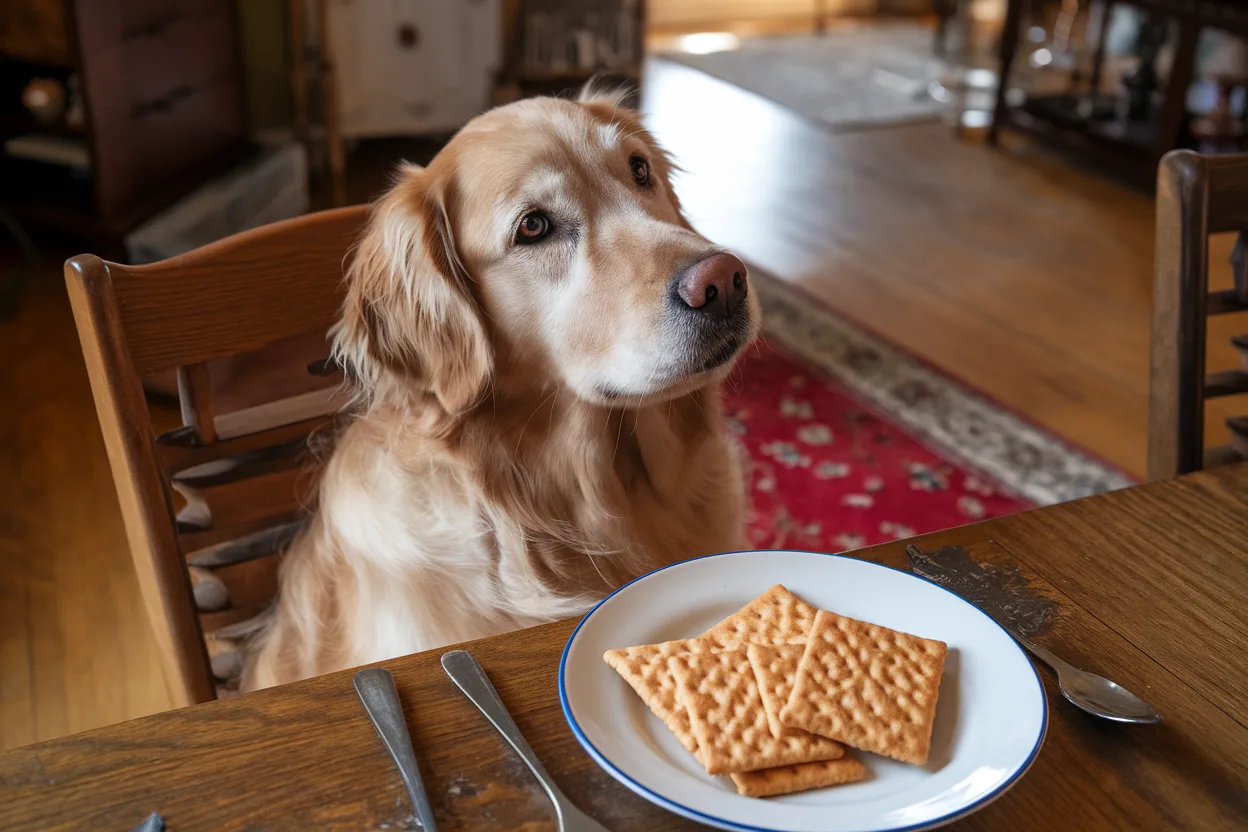Can Dogs Eat Graham Crackers?
Many dog owners often wonder: Can dogs eat graham crackers safely? While these lightly sweetened snacks are not toxic to dogs, they aren’t the healthiest treat for your furry friend. Understanding the potential risks and nutritional shortcomings of graham crackers is crucial to ensuring your pet’s well-being.
For a deeper understanding of dog-friendly foods, check out PetMD’s guide to dog nutrition. It provides valuable insights into what makes a safe and healthy treat for dogs.
What Are Graham Crackers?
Graham crackers are human snacks made from graham flour, a coarsely ground whole wheat flour, along with sugar, honey, and other ingredients. They are loved for their mild sweetness and crunchy texture, but their nutritional content doesn’t align well with a dog’s dietary needs.
For healthier treat ideas that cater specifically to dogs, explore AKC’s suggestions for safe dog treats. They offer a range of options tailored to canine health.
Nutritional Content of Graham Crackers
Key Nutrients Found in Graham Crackers
- High in carbohydrates and sugar, which provide quick energy but can lead to weight gain in dogs.
- Contain small amounts of calcium and iron, but these are minimal and not a significant nutritional benefit for dogs.
- Lack essential proteins, fats, and fibers required for a balanced canine diet.
While graham crackers are safe in moderation, their sugar content can pose risks when consumed regularly or in large quantities.
Potential Risks of Feeding Graham Crackers to Dogs
Feeding graham crackers to dogs comes with certain risks. While they may seem harmless, consider these factors:
- High Sugar Content
Excessive sugar can lead to obesity, diabetes, and dental issues in dogs. Long-term consumption may cause significant health problems, including liver strain. - Processed Ingredients
Many graham crackers contain artificial additives or preservatives that could upset a dog’s digestive system or trigger allergic reactions. - Allergy Risks
Ingredients like wheat or honey can cause allergic reactions in sensitive dogs. Symptoms may include itching, vomiting, or diarrhea.
If your dog accidentally eats a large amount of graham crackers, monitor for symptoms such as lethargy, bloating, or digestive discomfort and contact your veterinarian.
How Graham Crackers Affect Dogs’ Digestion
Dogs have a digestive system designed to process meat-based diets, not processed carbohydrates. The refined sugars and wheat in graham crackers can:
- Cause stomach upset, including gas or diarrhea.
- Lead to blood sugar spikes, which can harm dogs with existing health conditions.
Moderation is key if you choose to share this treat with your pet.
Safe Treats and Alternatives for Dogs
If you’re looking for healthier snack options, there are plenty of alternatives to graham crackers. Consider these dog-friendly treats:
- Fruits: Apples (without seeds), blueberries, and watermelon.
- Vegetables: Carrot sticks, green beans, or cucumber slices.
- Store-Bought Treats: Look for low-calorie and grain-free options tailored for dogs.
For DIY enthusiasts, ASPCA’s guide to homemade dog treats offers simple, nutritious recipes you can try at home.
Guidelines for Feeding Graham Crackers to Dogs
If you still want to offer graham crackers as an occasional treat:
- Limit the Portion Size: Give only a small piece as an occasional snack.
- Check the Ingredients: Avoid crackers containing chocolate, xylitol, or excessive sugar.
- Monitor Your Dog’s Reaction: Watch for any signs of allergies or digestive discomfort.
Homemade Graham Cracker Alternatives for Dogs
For a safer alternative, try making dog-friendly graham crackers at home. Use these simple ingredients:
- Oat flour or rice flour (instead of wheat flour).
- Unsweetened applesauce as a sweetener.
- Peanut butter (ensure it’s xylitol-free).
Bake these ingredients into small, crunchy treats that mimic the texture of traditional graham crackers without the harmful additives.

FAQs About Dogs and Graham Crackers
What Happens If My Dog Eats Graham Crackers?
If your dog eats a small amount of graham crackers, they will likely be fine. However, consuming large quantities can lead to issues such as:
- Digestive discomfort (e.g., bloating, gas, or diarrhea).
- Blood sugar spikes, especially in dogs with diabetes.
- Weight gain if consumed frequently over time.
Monitor your dog for symptoms like lethargy or vomiting after eating graham crackers. If any unusual symptoms appear, contact your veterinarian.
What Kind of Crackers Can Dogs Eat?
While most human crackers are not ideal for dogs, some types are safer in moderation. Consider these options:
- Plain rice crackers: Ensure they contain no added salt or seasonings.
- Whole grain crackers: Choose low-sodium and unsweetened varieties.
- Homemade crackers: Use dog-safe ingredients like oat or rice flour and unsweetened applesauce.
Avoid crackers with ingredients like garlic, onion, or artificial sweeteners (e.g., xylitol), which are toxic to dogs.
Are Graham Crackers Safe?
Graham crackers are generally safe for dogs to eat in small amounts, but they aren’t a healthy choice. Their high sugar and carbohydrate content can contribute to weight gain, dental issues, and long-term health problems if given regularly. Always feed them as an occasional treat, not as a regular snack.
What Are the Ingredients in Honey Maid Graham Crackers?
Honey Maid graham crackers typically include:
- Whole grain wheat flour
- Sugar
- Canola or palm oil
- Honey
- Salt
- Baking soda
- Artificial flavoring
These ingredients make them tasty for humans but less suitable for dogs due to the sugar, oil, and artificial flavors. Always read labels carefully before sharing human snacks with your pet.
Here’s the article using internal links from the sitemap of recipetastiy.com:
Can Dogs Eat Graham Crackers?
Many pet owners often wonder whether graham crackers are a safe snack for their furry companions. While these crackers are not inherently toxic to dogs, their high sugar content and processed ingredients make them less than ideal for canine consumption. To understand the risks and alternatives, it’s crucial to look at both their nutritional content and how they affect dogs.
For tips on making better dietary choices for pets, check out The Ultimate Guide to Graham Crackers. It provides detailed insights into their composition and usage.
What Are Graham Crackers?
Graham crackers are a popular human snack made from graham flour, sugar, honey, and other ingredients. While they are delicious for humans, their nutritional makeup isn’t suitable for dogs in large quantities.
If you’re interested in exploring alternatives, you might enjoy learning about healthy snacks like rice crackers, which can also be adapted for canine diets.
Nutritional Content of Graham Crackers
Key Nutrients
- High in sugar and carbohydrates, which are harmful in excess for dogs.
- Minimal amounts of calcium and iron, offering little benefit to canine health.
- Low in protein and fiber, essential components for a dog’s diet.
Dogs that consume too much sugar risk developing obesity, diabetes, and other health complications. For balanced meal ideas, read about easy recipes to keep your dog healthy and happy.
Potential Risks for Dogs
Feeding graham crackers to dogs comes with risks, including:
- Weight Gain and Diabetes: High sugar content can lead to unhealthy weight gain and, over time, increase the risk of diabetes.
- Digestive Issues: Processed ingredients can upset your dog’s stomach, leading to vomiting or diarrhea.
- Allergic Reactions: Wheat and honey, common in graham crackers, may trigger allergies in some dogs.
Safer Alternatives to Graham Crackers
Instead of graham crackers, consider healthier and safer options:
- Fruits: Apples (without seeds), bananas, and blueberries.
- Vegetables: Carrot sticks and green beans.
- Dog-Specific Treats: Many commercial treats are specially designed to cater to a dog’s nutritional needs.
For more ideas, explore tips on creating balanced snacks that are both nutritious and delicious.
FAQs About Graham Crackers and Dogs
Can Dogs Eat Graham Crackers Safely?
Yes, but only in small amounts. Overconsumption can lead to health issues like weight gain and digestive problems.
Are There Graham Cracker Ingredients to Avoid?
Avoid crackers containing chocolate, xylitol, or artificial sweeteners, which are toxic to dogs.
What Should I Do If My Dog Eats Too Many Graham Crackers?
Monitor for symptoms like lethargy, bloating, or vomiting. Contact your veterinarian if symptoms persist.
Conclusion
While graham crackers are not inherently harmful to dogs, they provide no nutritional benefit and can pose risks if consumed in large quantities. Instead, opt for dog-specific treats or natural alternatives like fruits and vegetables. By making informed choices, you can ensure your pet’s diet remains safe and healthy.
For more snack ideas and nutritional insights, visit The Ultimate Guide to Graham Crackers. Prioritize your pet’s health by sticking to treats designed for their unique needs.
This article incorporates internal links effectively to connect relevant content, enhancing the SEO and readability of the site. Let me know if you’d like further adjustments!

